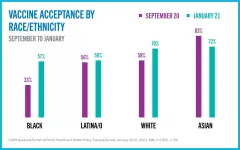(Press-News.org) A multi-institutional team became the first to generate accurate results from materials science simulations on a quantum computer that can be verified with neutron scattering experiments and other practical techniques.
Researchers from the Department of Energy's Oak Ridge National Laboratory; the University of Tennessee, Knoxville; Purdue University and D-Wave Systems harnessed the power of quantum annealing, a form of quantum computing, by embedding an existing model into a quantum computer.
Characterizing materials has long been a hallmark of classical supercomputers, which encode information using a binary system of bits that are each assigned a value of either 0 or 1. But quantum computers -- in this case, D-Wave's 2000Q - rely on qubits, which can be valued at 0, 1 or both simultaneously because of a quantum mechanical capability known as superposition.
"The underlying method behind solving materials science problems on quantum computers had already been developed, but it was all theoretical," said Paul Kairys, a student at UT Knoxville's Bredesen Center for Interdisciplinary Research and Graduate Education who led ORNL's contributions to the project. "We developed new solutions to enable materials simulations on real-world quantum devices."
This unique approach proved that quantum resources are capable of studying the magnetic structure and properties of these materials, which could lead to a better understanding of spin liquids, spin ices and other novel phases of matter useful for data storage and spintronics applications. The researchers published the results of their simulations -- which matched theoretical predictions and strongly resembled experimental data -- in PRX Quantum.
Eventually, the power and robustness of quantum computers could enable these systems to outperform their classical counterparts in terms of both accuracy and complexity, providing precise answers to materials science questions instead of approximations. However, quantum hardware limitations previously made such studies difficult or impossible to complete.
To overcome these limitations, the researchers programmed various parameters into the Shastry-Sutherland Ising model. Because it shares striking similarities with the rare earth tetraborides, a class of magnetic materials, subsequent simulations using this model could provide substantial insights into the behavior of these tangible substances.
"We are encouraged that the novel quantum annealing platform can directly help us understand materials with complicated magnetic phases, even those that have multiple defects," said co-corresponding author Arnab Banerjee, an assistant professor at Purdue. "This capability will help us make sense of real material data from a variety of neutron scattering, magnetic susceptibility and heat capacity experiments, which can be very difficult otherwise."
Magnetic materials can be described in terms of magnetic particles called spins. Each spin has a preferred orientation based on the behavior of its neighboring spins, but rare earth tetraborides are frustrated, meaning these orientations are incompatible with each other. As a result, the spins are forced to compromise on a collective configuration, leading to exotic behavior such as fractional magnetization plateaus. This peculiar behavior occurs when an applied magnetic field, which normally causes all spins to point in one direction, affects only some spins in the usual way while others point in the opposite direction instead.
Using a Monte Carlo simulation technique powered by the quantum evolution of the Ising model, the team evaluated this phenomenon in microscopic detail.
"We came up with new ways to represent the boundaries, or edges, of the material to trick the quantum computer into thinking that the material was effectively infinite, and that turned out to be crucial for correctly answering materials science questions," said co-corresponding author Travis Humble. Humble is an ORNL researcher and deputy director of the Quantum Science Center, or QSC, a DOE Quantum Information Science Research Center established at ORNL in 2020. The individuals and institutions involved in this research are QSC members.
Quantum resources have previously simulated small molecules to examine chemical or material systems. Yet, studying magnetic materials that contain thousands of atoms is possible because of the size and versatility of D-Wave's quantum device.
"D-Wave processors are now being used to simulate magnetic systems of practical interest, resembling real compounds. This is a big deal and takes us from the notepad to the lab," said Andrew King, director of performance research at D-Wave. "The ultimate goal is to study phenomena that are intractable for classical computing and outside the reach of known experimental methods."
The researchers anticipate that their novel simulations will serve as a foundation to streamline future efforts on next-generation quantum computers. In the meantime, they plan to conduct related research through the QSC, from testing different models and materials to performing experimental measurements to validate the results.
"We completed the largest simulation possible for this model on the largest quantum computer available at the time, and the results demonstrated the significant promise of using these techniques for materials science studies going forward," Kairys said.
INFORMATION:
This work was funded by the DOE Office of Science Early Career Research Program. Access to the D-Wave 2000Q system was provided through the Quantum Computing User Program managed by the Oak Ridge Leadership Computing Facility, a DOE Office of Science user facility located at ORNL. Research performed at ORNL's Spallation Neutron Source, also a DOE Office of Science user facility located at ORNL, was supported by the DOE Office of Science.
UT-Battelle manages Oak Ridge National Laboratory for DOE's Office of Science, the single largest supporter of basic research in the physical sciences in the United States. DOE's Office of Science is working to address some of the most pressing challenges of our time. For more information, visit https://energy.gov/science. -- Elizabeth Rosenthal
Wolves are arguably the most well-studied large predators in the world, yet new research shows there is still a lot to learn about their hunting tactics. Typically, wolves hunt large mammals like moose, deer, and bison in packs by outrunning, outlasting, and exhausting their prey. However, throughout the dense boreal forests in North America and Eurasia, during the summer wolves often hunt beavers by themselves.
But how does a wolf catch a semi-aquatic prey that spends little time on land and never ventures far from the safety of its pond? Turns out with patience, and a lot of waiting.
In a new paper published in the journal Behavioral Ecology, researchers from the University of Minnesota and the Voyageurs Wolf Project--which ...
CHICAGO: Elderly patients (70 years and over) with locally advanced esophageal (E) and esophagogastric junction (EGJ) cancer (located in the stomach and esophagus) should be considered for optimal therapy that has the potential to cure. This therapy regimen includes initial chemoradiotherapy (NACR) and surgical resection, an operation that removes the cancerous part of the organ.
According to researchers, this recommended therapy is often not offered to elderly patients out of concern that they will not tolerate such an intensive treatment regimen. In a new study, they found that older patients who received the therapy had outcomes comparable with those of younger patients (under 70 years old). The single-institution study from the Ochsner Clinic Foundation and The University of ...
PROVIDENCE, R.I. [Brown University] -- A new study finds that providing people who have recently given birth access to long-acting reversible methods of contraception, such as intrauterine devices and contraceptive implants, could help prevent them from unintentionally falling pregnant in the following months.
The study -- which analyzed the effects of a 2012 Medicaid policy implemented in South Carolina -- found that expanded access to particular forms of birth control were especially helpful in preventing unintended pregnancies among adolescents who had just given birth, giving them more control over their own futures.
"The ...
GRAND RAPIDS, Mich. (Feb. 9, 2021) -- Scientists have devised a new approach for detecting and potentially heading off the effects of two rare pediatric diseases before birth.
The study, performed in mouse models of the diseases and published today in Cell Reports, represents an important step toward much-needed early interventions for Beckwith-Wiedemann syndrome and Silver-Russell syndrome.
Both diseases result in growth-related symptoms in children and often lead to additional problems later in life, such as increased cancer risk from Beckwith-Wiedemann syndrome ...
The research team of NUST MISIS has presented an improved structure of perovskite solar cells. Scientists have modified perovskite-based solar cells using MXenes -- thin two-dimensional titanium carbides with high electrical conductivity. The MXenes-based modified cells showed superior performance, with power conversion efficiency exceeding 19% (the reference demonstrated 17%) and improved stabilized power output with respect to reference devices. The results have been published in the Nano energy international scientific journal.
Perovskite solar cells ...
Women whose household drinking water contained nitrate had babies that weighed, on average, 10 grams less than babies born to mothers where household water had no detectible nitrate, according to a new study from researchers at the University of Illinois Chicago and Aarhus University.
The study, which is published in the journal Environmental Health Perspectives, followed pregnant women living in Denmark. The researchers found that even low nitrate levels -- about half of the allowable level set by the U.S. Environmental Protection Agency, or EPA -- caused an adverse effect.
"While ...
Under the Biden Administration, New Yorkers' acceptance of the Covid-19 vaccine has increased significantly. In September, 55% of residents reported they would take the vaccine when it became available and this January, 64% reported they would take it.
Differences in vaccine acceptance persist across racial and ethnic groups. Among Whites and Asians acceptance is 70-72%; among Blacks and Latina/os it is 57-58%. On a positive note, the largest increase in rate of acceptance was seen among Black respondents, up from 33% in September to 57% in January.
These are key findings from the most recent tracking survey of public perceptions and experiences in New York City during the Covid-19 pandemic, conducted January 29-31 by the City University of New York Graduate School of ...
The colors in a flower patch appear completely different to a bear, a honeybee, a butterfly and humans. The ability to see these colors is generated by specific properties of opsins - light-sensitive proteins in the retina of our eyes. The number of opsins expressed and the molecular structure of the receptor proteins determines the colors we see.
In a paper published February 9 in Proceedings of the National Academy of Sciences a team of researchers led by Harvard University develop a novel method to express long wavelength invertebrate opsin proteins in vitro and detail the molecular structure of redshift (long-wavelength) ...
In 2018, a faulty electric transmission line ignited the Camp Fire in Northern California, ultimately consuming 239 square miles and several communities, including the town of Paradise, which was 95 percent destroyed. At least 85 people died.
Structures have been rebuilt, but some things are worse. In a paper published February 2, 2021 in the International Journal of Environmental Research and Public Health, scientists at University of California San Diego, with colleagues elsewhere, describe chronic mental health problems among some residents who experienced the Camp Fire in varying degrees.
Direct exposure to large-scale fires significantly ...
Photoionization of water involves the migration and solvation of electrons, with many transient and highly active intermediates. The process results in a large blue shift in the absorption spectrum, from the THz or gigahertz region to the visible range. While the behavior of low-density quasifree electrons excited by small pump power density has been investigated extensively, we still know little about the transient evolution of photoexcited plasma in liquid water. Valuable insights were recently provided by an international research team in a study published in Advanced Photonics.
According to Liangliang Zhang, physics professor at Capital Normal University in Beijing and one of the senior authors on the study, the physical mechanism of plasma evolution on the ...






